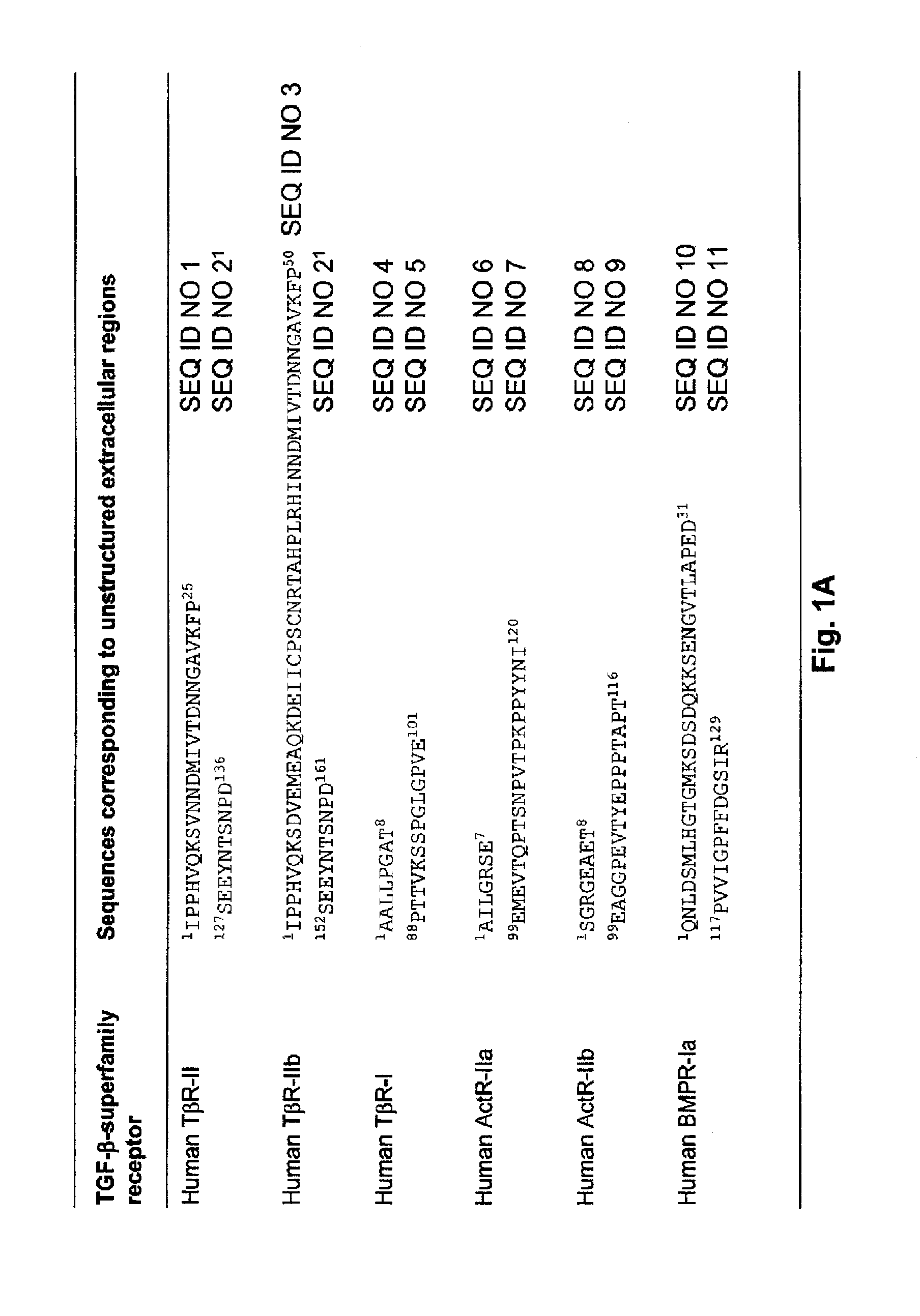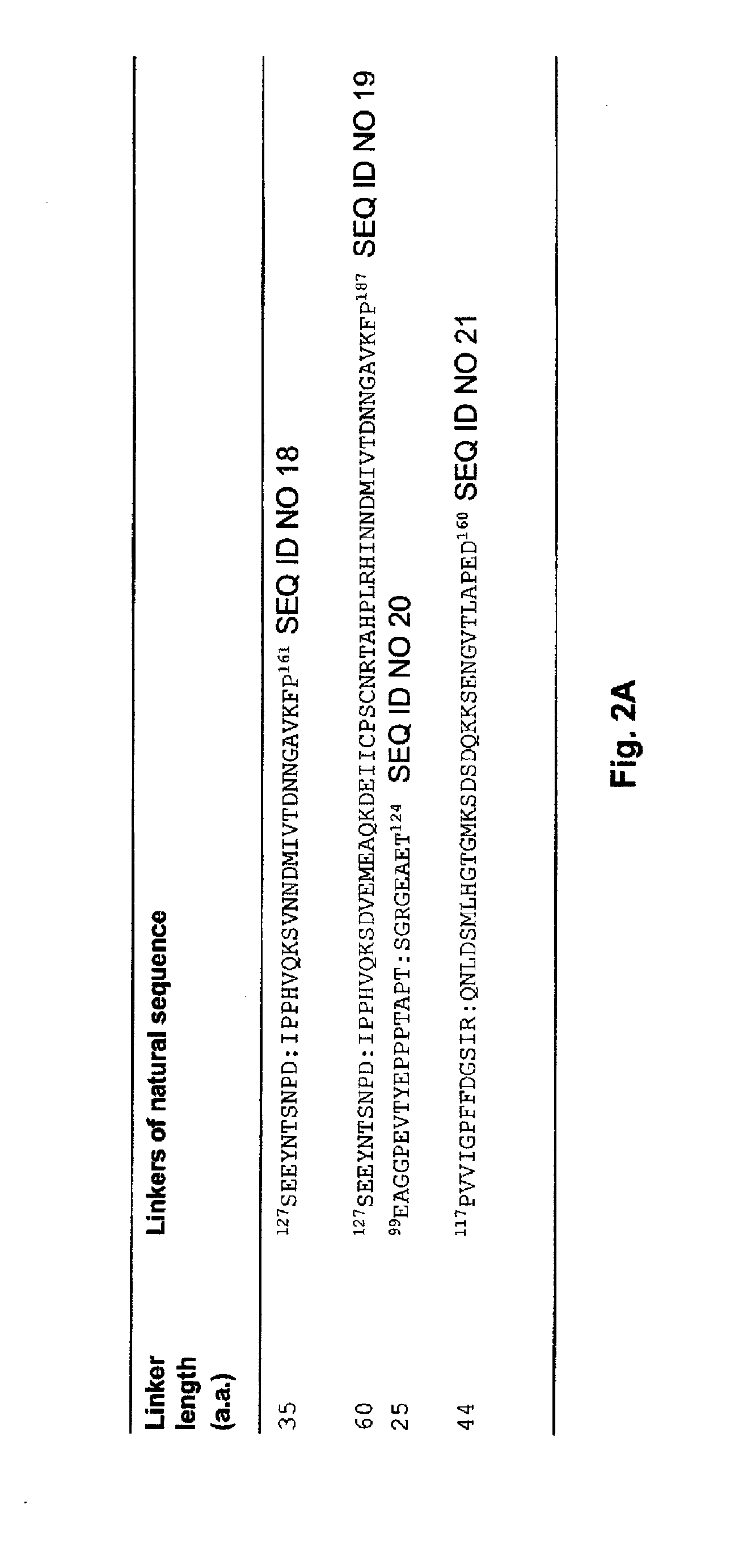Antagonists of ligands and uses thereof
a technology of ligands and antagonists, applied in the field of anti-ligands, can solve the problems of many undesirable biological processes, less than could be desired effect of monovalent trii-ed to antagonize tgf-, and inability to modulate the cellular respons
- Summary
- Abstract
- Description
- Claims
- Application Information
AI Technical Summary
Benefits of technology
Problems solved by technology
Method used
Image
Examples
example 1
Design Strategy of Single-Chain Traps for TGF-β-Family Ligands
[0131]1. Single-chain recombinant traps were designed against growth factors that belong to the transforming growth factor TGF-β superfamily of cysteine-knot cytokines according to SCOP (Andreeva et al., 2008, Nucl. Acid Res. 36: D419) and Pfam (Finn et al., 2006, Nucl Acid Res. 34: D247) structural classifications. More specifically, these growth factors including, for example, TGF-βs, activins and BMPs, share the same 3D architecture and form covalent disulfide-linked homodimers. The method disclosed herein is applicable to all members of the TGF-βsuperfamily, including TGF-β1, -β2, -β3; activin βA, βB, βC, βE; bone morphogenetic proteins (BMP) 2-15; growth differentiation factors (GDF) 1, 3, 8 (myostatin), 9 and 15; Nodal; Inhibin α; anti-Mullerian hormone (AMH); Lefty 1 and 2; Arteman, Persephin and Neurturin.
[0132]2. Single-chain recombinant traps against TGF-β superfamily growth-factors were designed from the extrac...
example 2
Feasibility Assessment Procedure for Designed Single-Chain Bivalent Traps
[0136]To the extent to which the structures of various TGF-β-superfamily growth factors are conserved, the structures of their cognate receptor ectodomains are conserved, and the 2:1 receptor-ligand binding stoichiometry is conserved, the concept of fusing two natural receptor ectodomain sequences to produce single-chain hetero-bivalent traps with improved in vitro ligand binding affinity and ligand neutralizing activity relative to respective monovalent receptor ectodomains is applicable to the entire family of TGF-β ligands. The feasibility of these ligand traps can be theoretically assessed routinely by following the stepwise procedure outlined below. Although the procedure is presented for hetero-bivalent single-chain traps, it also applies to other designs, e.g., hetero-multivalent single-chain traps (disclosed herein).
[0137]1. The linear distance is measured between the C-terminal main-chain carbon atom o...
example 3
Demonstration that Shale-Chain Homobivalent Traps (TβRII)2 and (TβRIIb)2 are Potent Neutralizers of TGF-β1 and TGF-β3 but not TGF-β2
[0142]Homo-bivalent single-chain recombinant traps (TβRII)2 and (TβRIIb)2 were prepared as previously described in published PCT application WO 2008 / 113185. The ability of purified (TβRII)2 to neutralize TGF-β was tested on Mv1Lu cells having a TGF-β-responsive luciferase reporter gene and compared with TβRII-ED monomer, TβRII-Fc, and pan-specific TGF-β neutralizing antibody 1 D11 (FIG. 3). The resulting inhibition curves (FIGS. 3A and 3B, and data not shown) allowed determination of the average IC50, a measure of neutralization potency for each TGF-β isoform (summarized in Table 4). (TβRII)2 and (TβRIIb)2 traps were respectively ˜100-fold and 1000-fold more potent than TβRII-ED for neutralizing TGF-β1 and TGF-β3. However, these homo-bivalent traps were unable to neutralize TGF-β2.
TABLE 4Trap IC50s (nM) determined from TGF-β neutralization curves.TrapIC...
PUM
| Property | Measurement | Unit |
|---|---|---|
| Length | aaaaa | aaaaa |
| Length | aaaaa | aaaaa |
| Length | aaaaa | aaaaa |
Abstract
Description
Claims
Application Information
 Login to View More
Login to View More - R&D
- Intellectual Property
- Life Sciences
- Materials
- Tech Scout
- Unparalleled Data Quality
- Higher Quality Content
- 60% Fewer Hallucinations
Browse by: Latest US Patents, China's latest patents, Technical Efficacy Thesaurus, Application Domain, Technology Topic, Popular Technical Reports.
© 2025 PatSnap. All rights reserved.Legal|Privacy policy|Modern Slavery Act Transparency Statement|Sitemap|About US| Contact US: help@patsnap.com



